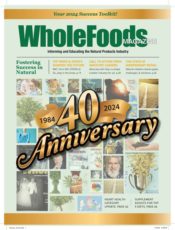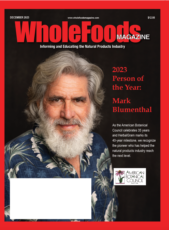Membrell’s JOINThealth is clinically proven for joint relief in just 7-10 days with just one capsule per day.
According to the Centers for Disease Control and Prevention, the number of Americans who suffer from chronic joint problems is much higher than once thought. The federal agency estimated in 1997 that 43 million U.S. adults experience pain, stiffness and swelling around the joints (1). However, new data show the number is more like 70 million—or an astounding one in three (2). Not surprisingly, the demand for products that can ease joint pain is high and is expected to keep growing as the population continues to trend older. 
While glucosamine is the most well-known of the natural joint health ingredients, it is notoriously slow-acting and many people do not benefit from it at all. The recent large-scale, multicenter Glucosamine/Chondroitin Arthritis Intervention Trial (GAIT) found that overall, glucosamine performed no better than placebo at relieving knee pain (3). Fortunately, there is a 100% natural, vegetarian, clinically proven alternative to glucosamine that works in as little as seven to 10 days: NEM® (natural eggshell membrane), featured in JOINThealth and JOINThealth Plus Antioxidants from Carthage, MO-based Membrell.
Clinically Proven Joint Relief in 7–10 Days
Membrell was founded in 2002 to utilize the significant health benefits of eggshells and eggshell membranes. Both JOINThealth and JOINThealth Plus Antioxidants feature 500 mg of NEM® per dose in vegetarian capsules—the exact daily dosage found effective in clinical studies.
Two recently published open-label human clinical studies (4) were conducted to evaluate the effectiveness of NEM® for the relief of pain and discomfort in various joints—primarily knees, hips and shoulders (4). In both studies, subjects took 500 mg per day of NEM® (one capsule) and were then evaluated at seven and 30 days. The first study showed that after just seven days, participants experienced a 28% increase in flexibility—and that figure jumped to 44% after 30 days. Simultaneously, NEM® reduced the pain patients experienced while flexing the affected joint by a remarkable 76%. The second study also demonstrated the fast-acting nature of NEM®: after just seven days, NEM® produced an average 25% reduction in pain, which increased to 30% by the end of 30 days.
The results of these two trials were impressive, but both the patients and the researchers were aware of the treatment. Would NEM® still be effective if it was tested in a randomized, double-blind, placebo-controlled trial? According to a soon-to-be published study, the answer is yes.
In the latest double-blind, placebo-controlled study, which recruited people with joint pain, half of the subjects were given NEM® and half were given a placebo (5). Compared to placebo, NEM® produced an average 15% reduction in pain and an average 13% reduction in stiffness in just 10 days. After 60 days, the pain response was maintained, while stiffness continued to improve, registering an average 27% reduction. In fact, by the end of the trial, NEM® had cut stiffness in half for the majority of patients.
How JOINThealth Works
Eggshell membrane is one of the only substances on earth that naturally contains a range of constituents needed to rebuild cartilage and connective tissue, including key glycosaminoglycans like chondroitin and hyaluronic acid, as well as collagen and other proteins. The unique combination of so many joint health nutrients in one natural ingredient may be a key factor to JOINThealth’s fast, one-bottle results.
Eggshell membrane is not the only therapeutic part of the egg, however. Membrell has also harnessed the power of eggshell calcium to build bone in its BONEhealth product.
Support for Bones, Too
BONEhealth features ESC® (Eggshell Calcium), a 100% natural, highly concentrated source of calcium plus soluble proteins that are thought to enhance calcium absorption. In fact, in vitro studies demonstrate an almost 20% increase in calcium bioavailability with ESC® compared to calcium carbonate (6). BONEhealth also includes magnesium and vitamin D3 to ensure the body can optimally utilize the calcium.
Natural, ultra-refined ESC® is free of problems that plague other calcium products such as digestive discomfort, bloating and lead contamination. As a matter of fact, the ESC® in BONEhealth is FDA-, USP- and CA Prop 65-compliant for limits on heavy metals. 
Recycling a Natural Resource
“Environmental sustainability” has become quite the buzz phrase, with more and more companies striving to minimize the footprint they leave on the earth. Membrell has a loftier goal: to go beyond simply sustaining the environment to improving it. Every year, over 600,000 tons of eggshells are destined for the nation’s landfills. By harnessing the power of the egg, Membrell not only helps individuals experience a better overall quality of life, the company also helps clean up the earth at the same time.
References
1. Centers for Disease Control, “Prevalence of Arthritis—United States, 1997” MMWR Weekly, 50 (17), 334–336 (2001), www.cdc.gov/mmwr/preview/mmwrhtml/mm5017a2.htm.
2. Centers for Disease Control, “Prevalence of Self-Reported Arthritis or Chronic Joint Symptoms Among Adults—United States, 2001,” MMWR Weekly, 51 (42), 948–950 (2002), www.cdc.gov/mmwr/preview/mmwrhtml/mm5142a2.htm.
3. National Center for Complimentary and Alternative Medicine, “The NIH Glucosamine/Chondroitin Arthritis Intervention Trial (GAIT),” J. Pain Palliat. Care Pharmacother. 22 (1), 39–43 (2008).
4. K.J. Ruff et al., “Eggshell Membrane A Possible New Natural Therapeutic for Joint and Connective Tissue Disorders: Results From Two Open-Label Human Clinical Studies,” submitted for publication.
5. K.J. Ruff et al., “Eggshell Membrane in the Treatment of Pain and Stiffness from Osteoarthritis of the Knee: A Randomized, Multicenter, Double-Blind, Placebo-Controlled Clinical Study,” submitted for publication.
6. A. Schaafsma and G.M. Beelen, “Eggshell Powder, a Comparable or Better Source of Calcium than Purified Calcium Carbonate: Piglet Studies,” J. Sci. Food Agric. 79, 1596–1600 (1999).
Publishied in WholeFoods Magazine, February 2010









